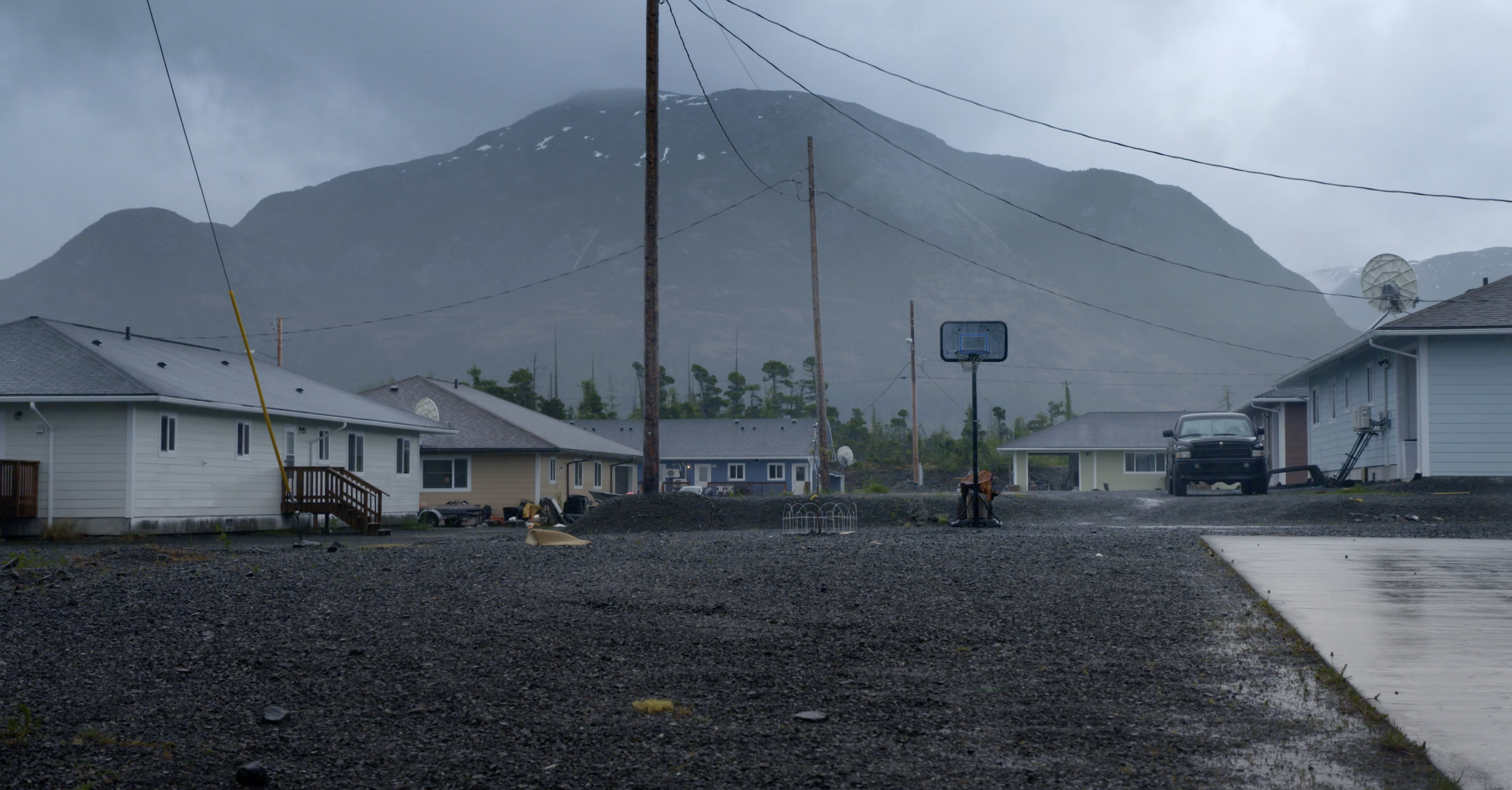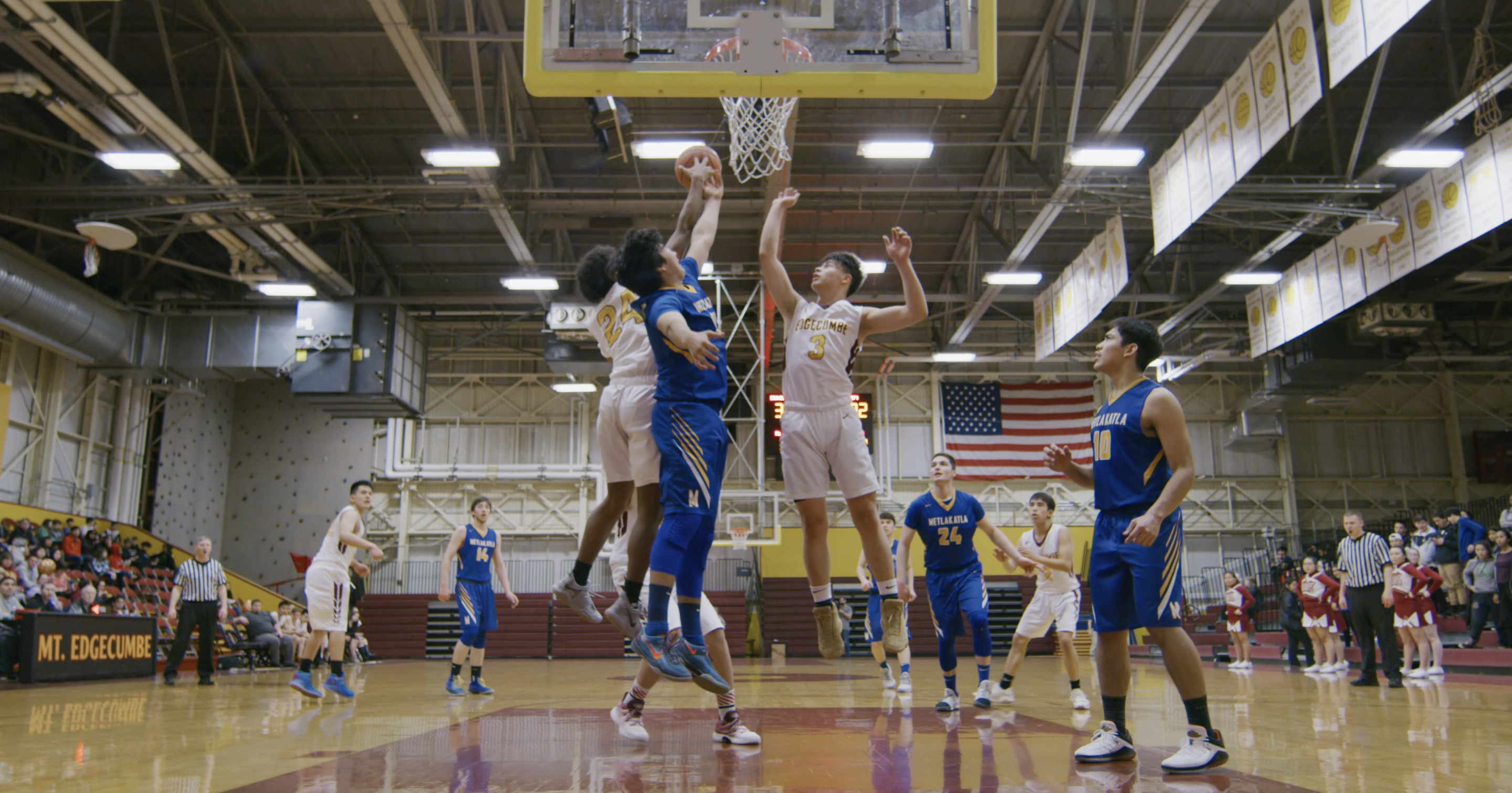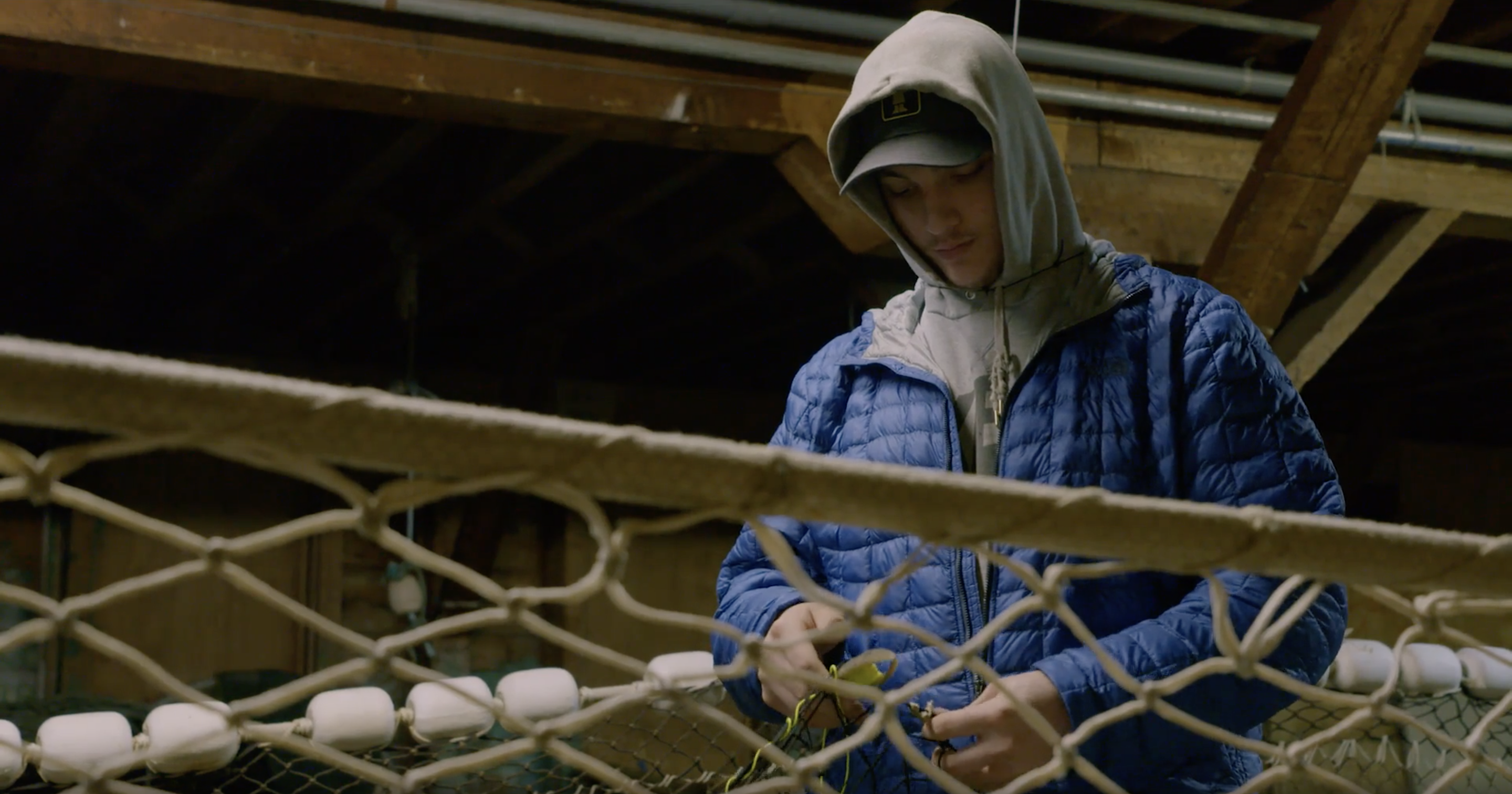‘Alaskan Nets’ Tells the Powerful Story of Metlakatla, Alaska’s Last Native Reserve, and Their Journey to a HS State Championship Title
In the opening minutes of Alaskan Nets, the camera pans over a stunning shot of the ocean, where a single boat is moving along the current. There’s a family of killer whales swimming around, and a bald eagle circles the skies. It then quickly cuts to another shot of the mountainside and hills that surrounds Alaska’s last remaining native reserve, the Metlakatla, home to the Tsimshian tribe, and in the center of all of this greenery and beauty, is a single basketball hoop on an empty field.
Listen, can you hear the pounding? Listen closely, you can hear it. It’s the basketballs bouncing.
For the small fishing reserve of the Metlakatla, a remote island located off the coast of Southeast Alaska, basketball isn’t just a sport or a passion, it’s the cadence of the entire community’s heartbeat. The game has been played by generations, and during the most difficult of times, it’s brought hope when hope might seem far, far away.
“It’s just who we are, and what we do.”
The award-winning film, which is available to rent and download now, captures that unwavering love and passion while taking viewers along the Metlakatla Chiefs quest to bring another high school basketball championship to the island, the first title since 1984. Directed by Jeff Harasimowicz, Alaskan Nets captures their two stars, cousins Danny Marsden and DJ King, as they navigate their responsibilities to another net, fishing, to support their families. In one scene, DJ even admits that if it wasn’t for basketball, he wouldn’t even want to attend school. Instead, he’d be out there on the water to financially help his family.
All the while, basketball also provides a sense of immense healing for the community—both of DJ’s uncles, who also played on the Chiefs, tragically committed suicide at a young age, and when another death in the family shakes the town, right in the middle of the Chief’s season, the game continues to be fuel their sense of purpose.
“One thing that always goes through my mind is, I need to win a state title. That’s the one thing that’ll bring peace,” DJ says.
To tell this story takes immense trust—trust from the community, the players, and the tribe. SLAM recently caught up with Harasimowicz to learn more about how he gained permission from the Tsimshian tribe to film Alaskan Nets, what the filmmaking process was like, and ultimately, how much basketball means to the community.
SLAM: To start off, how did you first learn about Metlakatla and how did this project come about?
Jeff Harasimowicz: I had always been interested in doing a sports documentary. I’m a huge sports fan, myself, and I take a lot of joy and pride in good sports movies. So I’ve been looking for a story for a while and I honestly kind of stumbled across it. I stumbled across this photo essay about Metlakatla, and it was pretty short. There’s probably 10 photos or so and maybe a couple of short paragraphs, maybe even just a few sentences, really. But once I saw the images [and] heard about this community, I was struck. It was the only native reserve in Alaska that surprised me. The fact that basketball was akin to religion that super surprised me. And then the fact that these kids, who are commercial fishermen, providing for their families, in a very dangerous industry, are also the ones responsible for playing basketball and bringing hope and joy and pride to this community. It was just a story that was too good to pass up. So, I saw that I knew I had to figure out a way to do it.

SLAM: What was the process like to get permission from the Tsimshian to tell this story?
JH: I reached out to the coach. I ended up tracking down the coach’s email, and when I emailed him, he was actually in the process of losing the state championship game that year. So, he was a little a little sour and didn’t want to get back to me right away. But a couple weeks later, he got back to me…He invited me to come up and meet the community. He’s an outsider, so he has no sway whatsoever, but he said, You need to come up and meet the tribal council that govern the island. There’s a 12 person council, kind of led by the mayor. I was invited up and I think I took three total trips to the community to spend time with the different leaders and just talk about the vision for the project and let them meet me a little bit and get a sense for who I was, and you know, the idea for the project and what was going to be needed. And then it kind of all came down to this kind of official presentation—I had to go before the tribal council [in the summer of 2017] and make them a pitch and stand before them [to] say what my intentions were, how I was going to do it and answer their questions. Then I was asked to leave and they [voted] on whether or not we could move forward. Ultimately, we were granted permission thank goodness, and the rest is history.
I was never concerned about dishonoring them or doing anything to upset them, but we didn’t know that they had this kind of veto power called the ‘blue ticket,’ where if they don’t want someone on their island, they can issue a blue ticket and you’re effectively kicked off the island for any reason. It was very much like come on in, but be careful.
SLAM: What was it like for you when you visited the island for the first time? Do you remember what your first impressions were?
JH: My very first time in Alaska was going to Metlakatla to meet [the] people in this community for the very first time. I think, like many people, and I’m definitely stereotyping here, but probably more young men like the idea of Alaska—it has this drawn, romantic appeal of the wildlife, the hunting, the fishing and adventure, and you think of you [authors like] John Muir and others. So, I was super gung-ho to go there and was super excited.

I get off the plane in Ketchikan and it’s on this little island, you have to take a ferry over, and there’s this bald eagle everywhere and fields. I’m like, Oh, man, I am in Alaska right now. The basketball coach had actually taken his fishing boat over to Ketchikan to pick me up, so that was my first time really meeting him. I remember throwing my bag in the back of a fishing boat and him taking me across. It was probably the roughest ride I had been on in a boat to that point in my life. That was kind of a welcome to Alaska moment really quick.
SLAM: As a filmmaker, how did you go about gaining the trust of the community to be able to film them and their lives so closely?
JH: Honestly, I had never done anything quite like this before. I had always been producing and you kind of stay home for the most part, like you’re at a desk or in an office, occasionally you’ll go to set. But really, it’s like, you’re kind of at home. This [was] the first time I was not at home, I was very much away. [It] was a whole new experience. When I first went in, I wanted to be all virtuous of like, okay, I’m going to draw a fine line and I’m not going to interact with the people too much, it’s more, I’m going to be a fly on the wall [and] observe. I think that lasted like a day, maybe two.
I think part of that was the nature of the community is they’re so warm, they’re so friendly, and they’re so inviting that, to be a fly on the wall in Metlakatla is not possible. You’re going to be a guest in their home for dinner, whether you like it or not, or you’re going to be invited to go hunt, or go fish, or go down to the market. You kind of just become part of the family really quick. I think the trust was earned fairly quickly, and I don’t necessarily know why, in a sense, like, I don’t want to toot my own horn, I just think they felt very comfortable with us. We kind of blended in, like we were low profile, and we just kind of went in and just did what they did, and went where they went and kind of said yes to everything. I think very quickly it felt like we were just part of the community and they treated us as such. I think if you watch the movie, there’s many times whether it’s emotional highs or lows, or even kind of like quasi embarrassing moments for some characters, they don’t even flinch. They don’t act differently, they act like we’re not even there. And I think that’s a real testament to the comfort level that was achieved, and I think the only way that’s possible is to live amongst your subjects and truly be there with them because once we were there, we were there. We didn’t just leave throughout the story.
SLAM: What was it like to see these athletes have to balance their tradition and the responsibilities they had to their families jobs with the game of basketball?
JH: I stand in awe of these kids, if you can even call them kids. That was kind of the one [thing] that we learned in this process, we kind of had an idea that was going to be the case. You think of, you know, probably 95% of athletes in the country, maybe even more, have a pretty comfortable life when you think of like what they’re faced with. Most kids don’t have jobs that are kind of life and death, first and foremost. Most kids don’t have the responsibility of providing for their families, because if they don’t, they could go hungry and there could be real issues that result from that. You don’t have kids who are just dealing with so much mature content for a young person. I think in many ways the kids that we were filming and living with felt like adults in many ways in terms of what they were exposed to, both in terms of work, of pressure, responsibility, tragedy and trauma. I stand in awe of them, knowing [that] what they go through, so few people I think could really go through it themselves and come out the same person on the other side.
SLAM: Can you talk more about the communities’ deeply rooted, spiritual connection to the game, and what you observed?
JH: I think it’s everything from the fairly seemingly innocuous things like [the players saying], If not for the game of basketball, I would not go to school, like I would literally just go fish. The only reason why I go to school is to be on the basketball team and to play the thing that brings us pride and joy and all that. I think probably the ultimate representation of that love for basketball takes place when [their] former star of the basketball team, dies in the middle of the season. When he passed away, it sent shockwaves through the community, and, whereas a lot of communities and teams who are so connected would probably just kind of fall apart in mourning, it became this rallying cry where it’s like, the only thing that’s gonna make [his death] better is winning a state title. That’s a crazy sentiment to have. I mean, I could understand a [few] people feeling that way, like, We just need something to be happy for. But no, it was his dad [who] told Danny and DJ, the stars of the team, his nephews, “Go win state.” To hear a father, who just lost his son, go tell the basketball team, you need to win it—that is the representation of what basketball means. It is life and death, and winning can bring life back in some small way to a community that’s been dealt with so much grief.

SLAM: Representation is so incredibly important, especially when telling these about native communities, is incredibly important. As filmmaker, what does this project mean to you and what is it like having that responsibility to tell their story?
JH: I take a lot of pride in what we did, in the sense that I think we did it. Throughout the process, it was important for us to earn their trust, and truly earn it, not, oh just let us do what we’re going to do. It was really to involve them in the process, and they were friends with us, they became family with us and I think that bond will remain for many years. But really, when you get that level of trust and love, a lot of responsibility comes with it, because their literally handing you their lives with an open door saying, Come on in. You’re seeing them at some really great moments, but also at some really horrible moments, and you feel a lot of pressure. This is not obviously a culture to which I am part, there’s so many things that were foreign and new to me, but I know that throughout that process we were respectful of their world, of their tradition, of their customs [and] making sure they were comfortable with what we were doing. Nothing was forced, nothing was coerced, everything was done in kind of lockstep with them.
Even the final version of the film, like when we finished the film, [which was] kind of tricky because COVID broke out right when we finished and our plans for showing them are kind of altered, but ultimately, we brought the film to their community and showed it at their longhouse over the course of a long weekend. We let the whole community watch it, and it’s like, the emotion, the pride, the joy that we saw was evident to us that we had done what we were supposed to do and treated our subjects, not as subjects but as family and friends. That’s the most important thing to me, especially wading into a world that is not your own. You really just needed to, in a way, be hands off and let them tell their own story. And I think that’s what we did.
